Transcript
ReachMD Announcer:
This program is brought to you by Regeneron. The speaker is a paid consultant.
Dr. Turck:
Welcome to Eye on Ocular Health on ReachMD. I'm Dr. Charles Turck, and it’s a pleasure to have you join us again as we review clinical trial data and a patient case for EYLEA® (aflibercept) Injection 2 milligrams in Macular Edema following Retinal Vein Occlusion, or RVO.
And, once again, we're honored to have Dr. John Kitchens with us on behalf of Regeneron Pharmaceuticals. Thank you for your ongoing participation in this discussion.
Dr. Kitchens:
Thank you, Dr. Turck. I’m looking forward to continuing our conversation.
Dr. Turck:
But before we begin our discussion, let’s take a moment to review the Indications and some Important Safety Information for EYLEA.
Narrator:
IMPORTANT SAFETY INFORMATION AND INDICATIONS
INDICATIONS
EYLEA® (aflibercept) Injection 2 mg is indicated for the treatment of patients with Neovascular (Wet) Age-Related Macular Degeneration (AMD), Macular Edema following Retinal Vein Occlusion (RVO), Diabetic Macular Edema (DME), and Diabetic Retinopathy (DR).
CONTRAINDICATIONS
EYLEA is contraindicated in patients with ocular or periocular infections, active intraocular inflammation, or known hypersensitivity to aflibercept or to any of the excipients in EYLEA.
Dr. Turck:
Now, Dr. Kitchens, in a separate discussion, we reviewed the results of 3 pivotal clinical trials with EYLEA as treatment for patients with Macular Edema following RVO. In this discussion, we’ll consider the case of a patient with Macular Edema following Branch RVO. Before we begin, would you mind giving us a refresher of the study design of the VIBRANT clinical trial, which included patients with this condition?
Dr. Kitchens:
[Slide on screen]
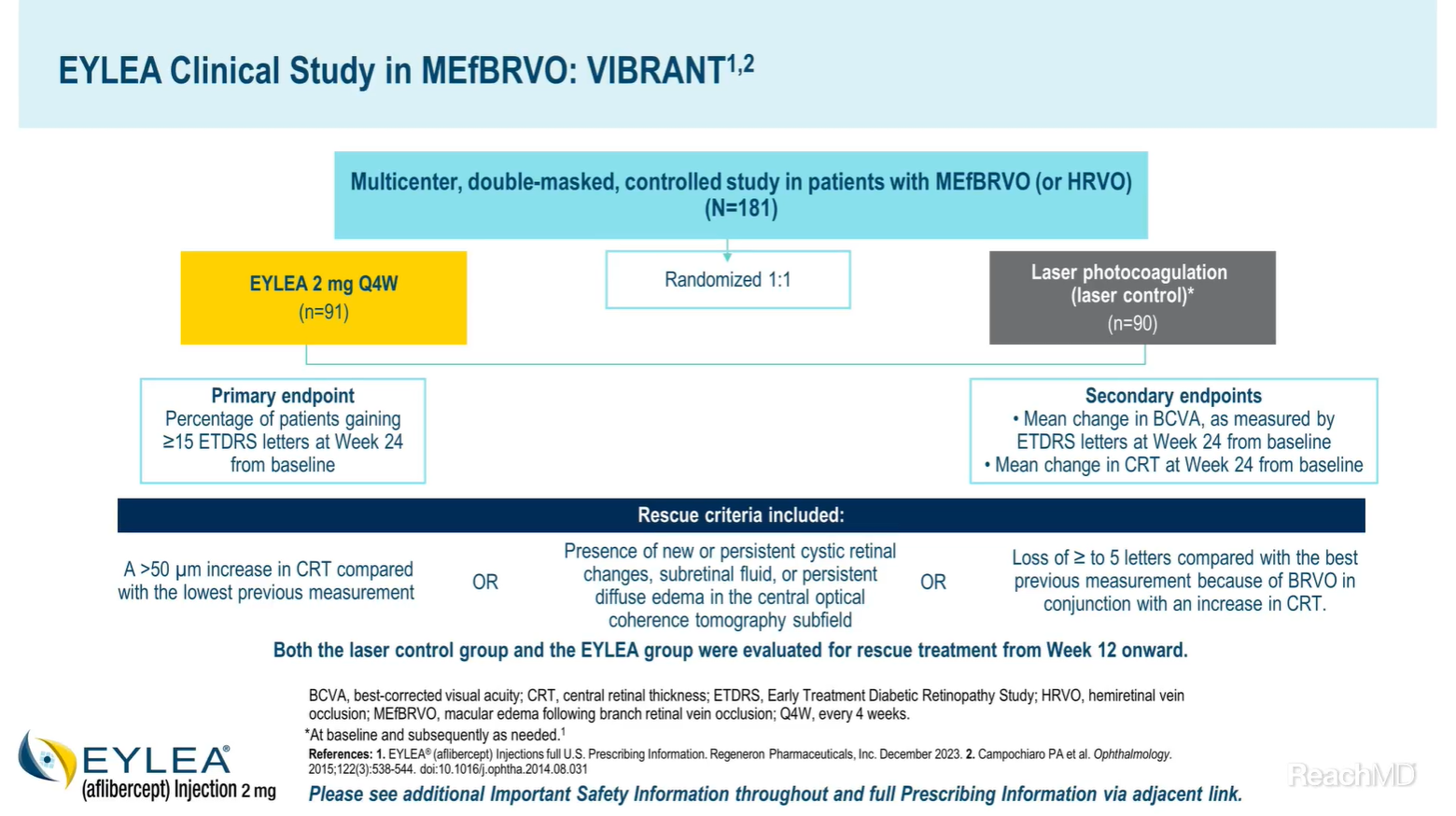
Absolutely. As previously mentioned, VIBRANT was a multicenter, randomized, double-masked controlled trial in patients with Macular Edema following Branch Retinal Vein Occlusion. A total of 181 patients with Macular Edema following Branch Retinal Vein Occlusion or HRVO were randomly assigned in a 1:1 ratio to receive either EYLEA® (aflibercept) Injection 2 milligrams every 4 weeks or laser photocoagulation, otherwise known as laser control, administered at baseline and subsequently as needed. The primary endpoint was the proportion of patients gaining 15 or more Early Treatment Diabetic Retinopathy Study, or ETDRS, letters of best-corrected visual acuity, or BCVA, at Week 24 from baseline.1,2
Secondary endpoints were mean change in best-corrected visual acuity, as measured by ETDRS letters, and mean change in central retinal thickness, or CRT, at Week 24 from baseline.1,2
Dr. Turck:
Thank you, Dr. Kitchens. And what about the efficacy results, could you please provide us with a summary?
Dr. Kitchens:
[Slide on screen]

Of course. As you can see here, the primary endpoint in the VIBRANT trial was met, with 53% of patients in the EYLEA group gaining 15 or more ETDRS letters versus 27% in the laser control group at Week 24.1,2
Additionally, patients achieved mean gains of 17 ETDRS letters at Month 6 in the VIBRANT trial.1-3
[Slide on screen]
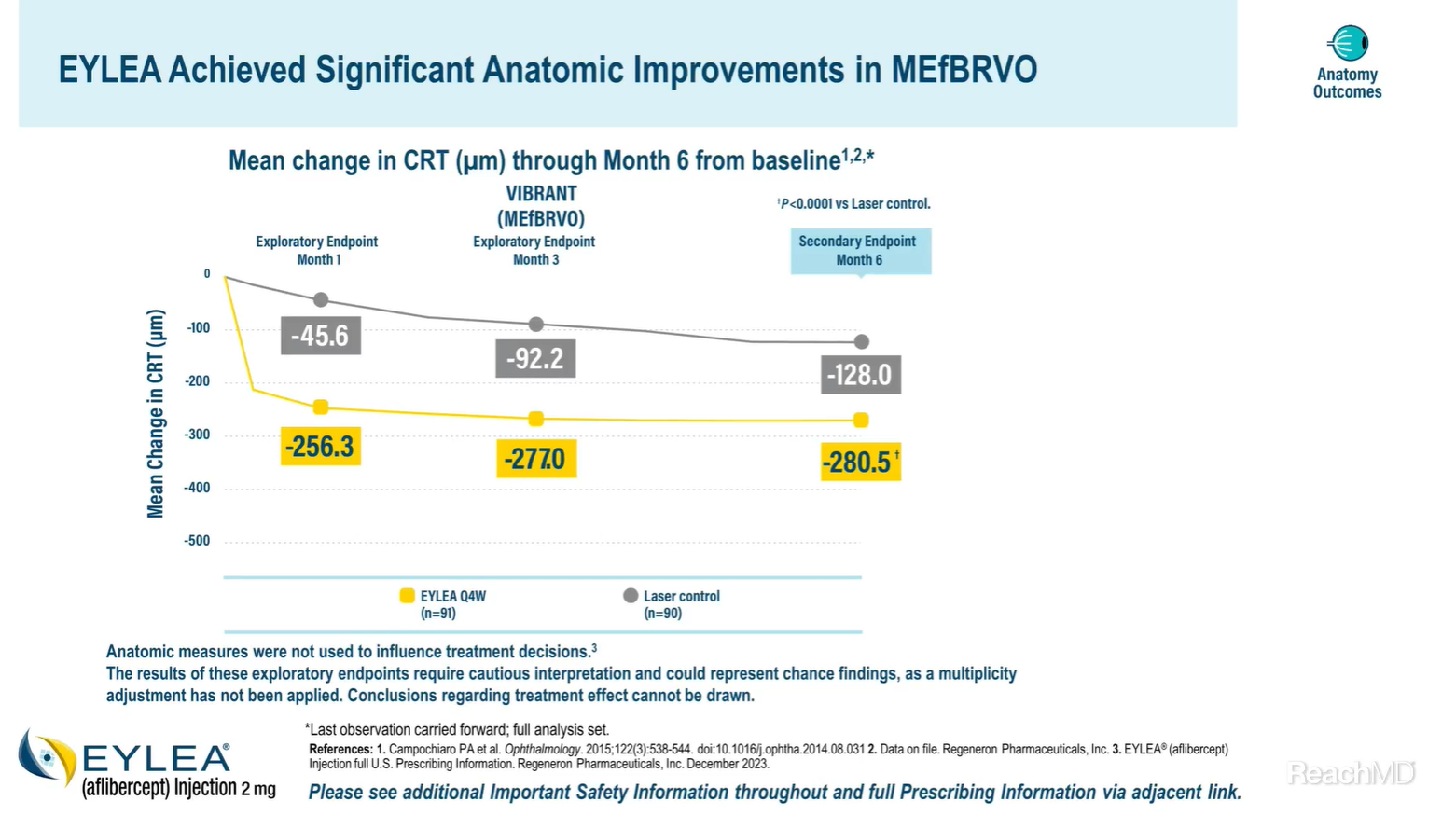
As with vision gains, anatomical improvements in Macular Edema following Branch Retinal Vein Occlusion were also demonstrated with EYLEA® (aflibercept) Injection.2
Treatment with EYLEA resulted in reductions in CRT compared with laser control at Month 6. The mean reduction in CRT from baseline was 280.5 µm versus 128.0 µm at Month 6 in the EYLEA group vs the laser control group, respectively.2,3
Dr. Turck:
Thank you, Dr. Kitchens, for the VIBRANT trial background demonstrating that treatment with EYLEA in patients with Macular Edema following Branch RVO resulted in both vision gains and anatomical improvements.
Before we proceed to discussing a patient case, let’s take a moment to review some additional Important Safety Information for EYLEA.
Narrator:
WARNINGS AND PRECAUTIONS
Intravitreal injections, including those with EYLEA, have been associated with endophthalmitis and retinal detachments and, more rarely, retinal vasculitis with or without occlusion. Proper aseptic injection technique must always be used when administering EYLEA. Patients and/or caregivers should be instructed to report any signs and/or symptoms suggestive of endophthalmitis, retinal detachment, or retinal vasculitis without delay and should be managed appropriately.
Acute increases in intraocular pressure have been seen within 60 minutes of intravitreal injection, including with EYLEA. Sustained increases in intraocular pressure have also been reported after repeated intravitreal dosing with VEGF inhibitors. Intraocular pressure and the perfusion of the optic nerve head should be monitored and managed appropriately.
Dr. Turck:
I’m certain our audience is eager to hear about the use of EYLEA in the clinical setting. Dr. Kitchens, what can you tell us about the patient case we’ll be discussing today?
Dr. Kitchens:
[Slide on screen]

Well in this case, we will be exploring the management decisions for this patient at treatment initiation and follow-up made for a patient with Macular Edema following Branch Retinal Vein Occlusion who had decreased vision.
This was a 58-year-old white male who came in with a chief complaint of sudden loss of vision in the right eye 2 weeks prior to visit. He had a history of hypertension and hyperlipidemia, which are known risk factors for RVO.4 He had no ocular history, no relevant surgical or family history, and his social history is noncontributory.
[Slide on screen]
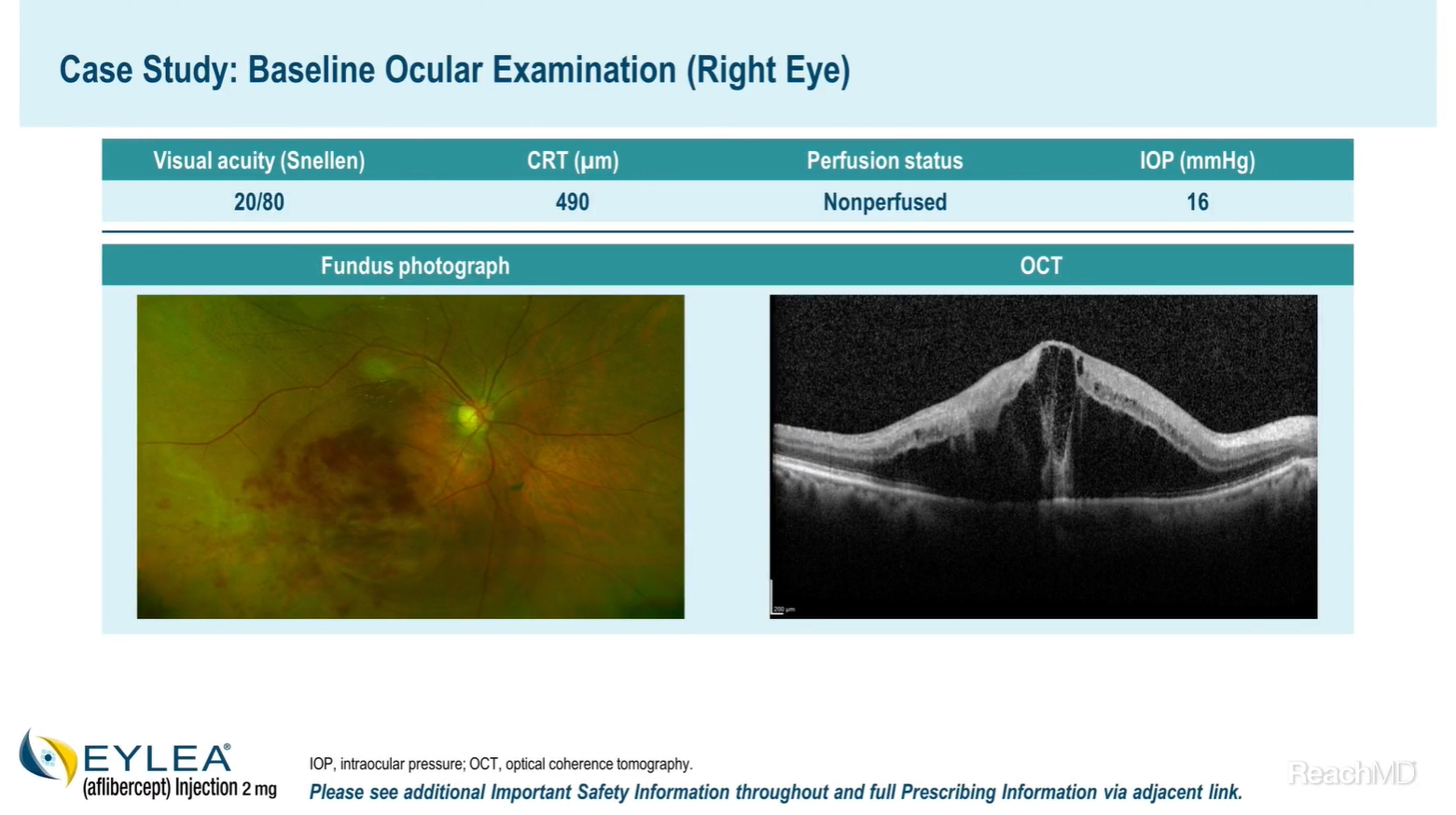
On examination, the patient’s visual acuity was 20/80 in the right eye. His intraocular pressure was 16 mmHg in the right eye. Adnexa, extraocular muscles, pupils, and anterior segment exam were all within normal limits in both eyes.
The fundus photograph showed an inferior Branch Retinal Vein Occlusion with significant hemorrhage and macular edema. The optical coherence tomography, or OCT, revealed significant macular edema with a CRT of 490 microns.
From here, we could start to think about the appropriate treatment approach for this patient, with the goal of achieving significant vision and anatomic gains as demonstrated in the VIBRANT clinical trial.2 Therefore, EYLEA® (aflibercept) Injection would be the treatment I would choose for this patient.
Dr. Turck:
Thank you for this background and for establishing the rationale for why you would use EYLEA® (aflibercept) Injection to treat this patient. Can you share how the patient responded?
Dr. Kitchens:
[Slide on screen]
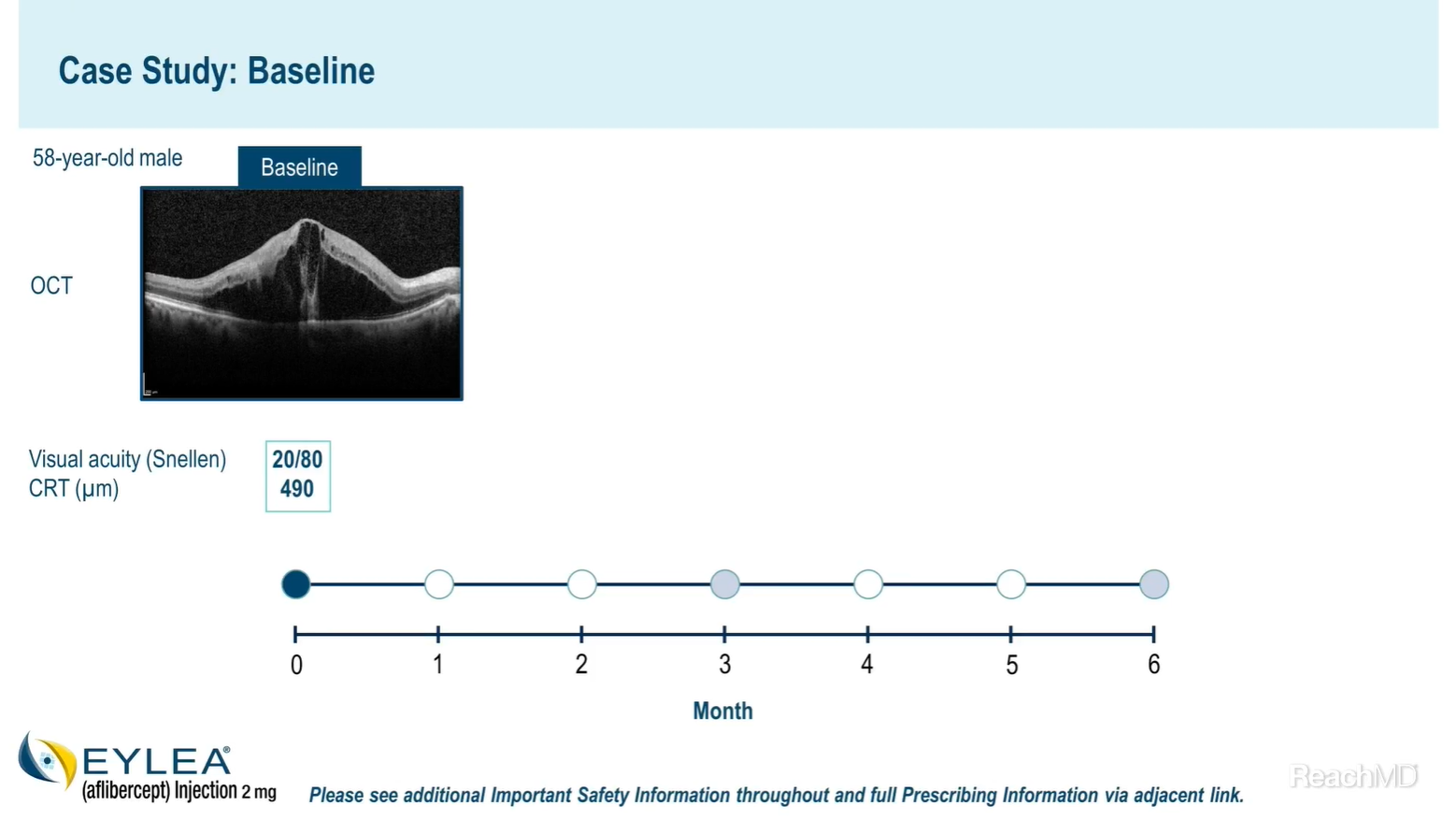
Of course. At the initial visit for this patient with Macular Edema following Branch Retinal Vein Occlusion, he was started on EYLEA with a dosing regimen of 2 milligrams every 4 weeks.
[Slide on screen]
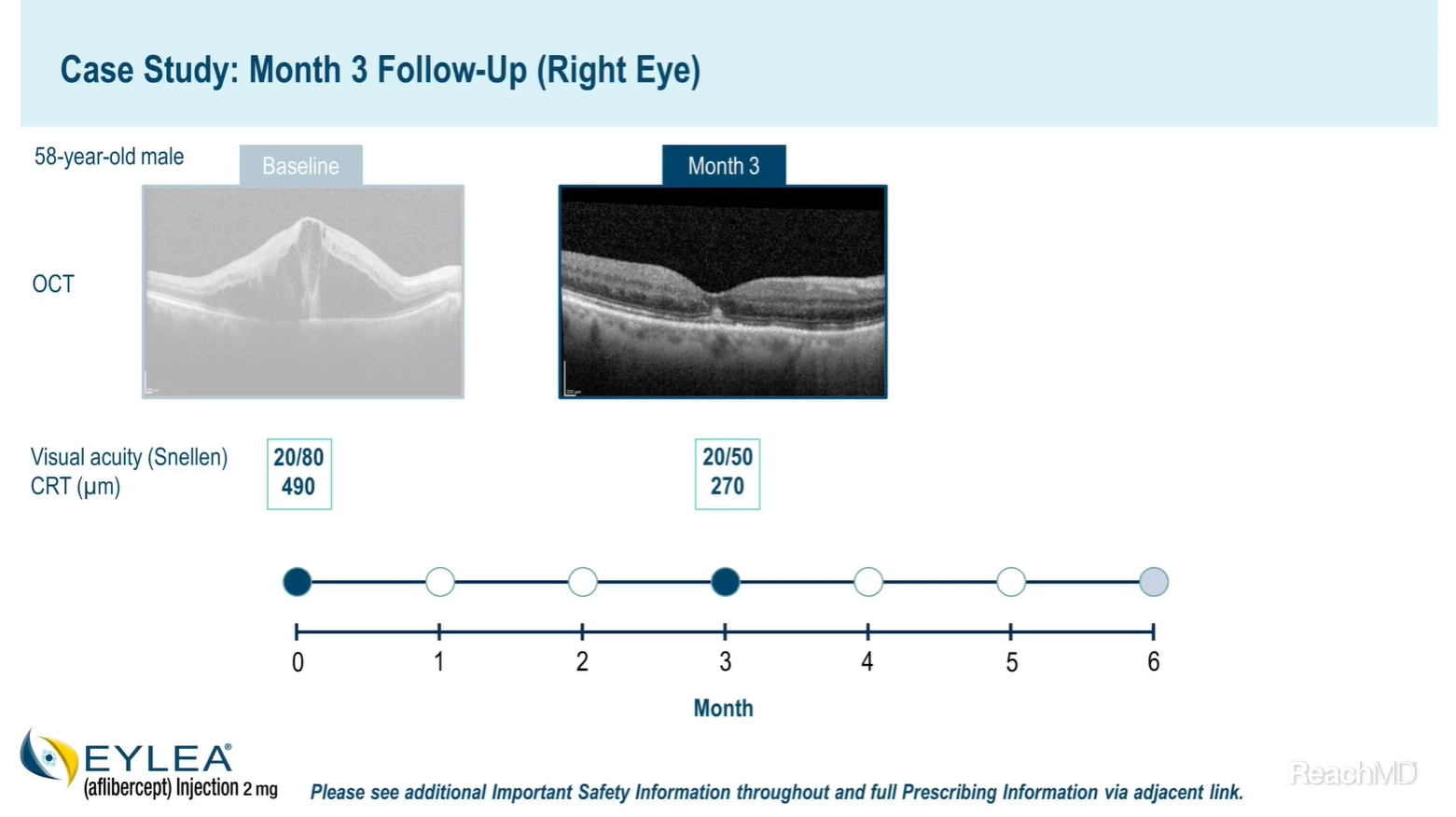
Next you can see his progress when the patient returned for his 3-month follow-up. The treatment response after 3 injections of EYLEA was demonstrated by the improved visual acuity and the reduction in CRT of 220 microns from his baseline visit. This rapid improvement was consistent with the results from the VIBRANT trial.2
[Slide on screen]

By Month 6, the CRT remained stable at 270 microns and his visual acuity had improved to 20/40. [Slide on screen]

Now to summarize this patient’s results from his baseline visit to Month 6, he experienced rapid improvements in visual acuity and CRT with EYLEA® (aflibercept) Injection 2 milligrams every 4 weeks, which were maintained at 6 months of follow-up.
This case was representative of clinical trial participants. For this case, the mean change in best-corrected visual acuity from baseline at Week 24 was +15 letters (going from 20/80 to 20/40) and the mean change in central retinal thickness, or CRT, was -220 μm. In VIBRANT, the mean change from baseline in best-corrected visual acuity in patients receiving EYLEA was 17.0 letters at Week 24 and the mean reduction from baseline central retinal thickness was 280.5 μm at Week 24.
Dr. Turck:
Thank you, Dr. Kitchens, for that informative case study. Before we proceed further, let’s take another moment to review some Important Safety Information regarding EYLEA.
Narrator:
WARNINGS AND PRECAUTIONS (continued)
There is a potential risk of arterial thromboembolic events (ATEs) following intravitreal use of VEGF inhibitors, including EYLEA. ATEs are defined as nonfatal stroke, nonfatal myocardial infarction, or vascular death (including deaths of unknown cause). The incidence of reported thromboembolic events in wet AMD studies during the first year was 1.8% (32 out of 1824) in the combined group of patients treated with EYLEA® (aflibercept) Injection compared with 1.5% (9 out of 595) in patients treated with ranibizumab; through 96 weeks, the incidence was 3.3% (60 out of 1824) in the EYLEA group compared with 3.2% (19 out of 595) in the ranibizumab group. The incidence in the DME studies from baseline to week 52 was 3.3% (19 out of 578) in the combined group of patients treated with EYLEA compared with 2.8% (8 out of 287) in the control group; from baseline to week 100, the incidence was 6.4% (37 out of 578) in the combined group of patients treated with EYLEA compared with 4.2% (12 out of 287) in the control group. There were no reported thromboembolic events in the patients treated with EYLEA in the first six months of the RVO studies.
Dr. Turck:
Coming back to you, Dr. Kitchens, now that we’ve discussed the patient case and some more Important Safety Information, let's take a closer look at the safety data for EYLEA. Could you start by telling us what were the most common adverse reactions from the VIBRANT trial?
Dr. Kitchens:
[Slide on screen]
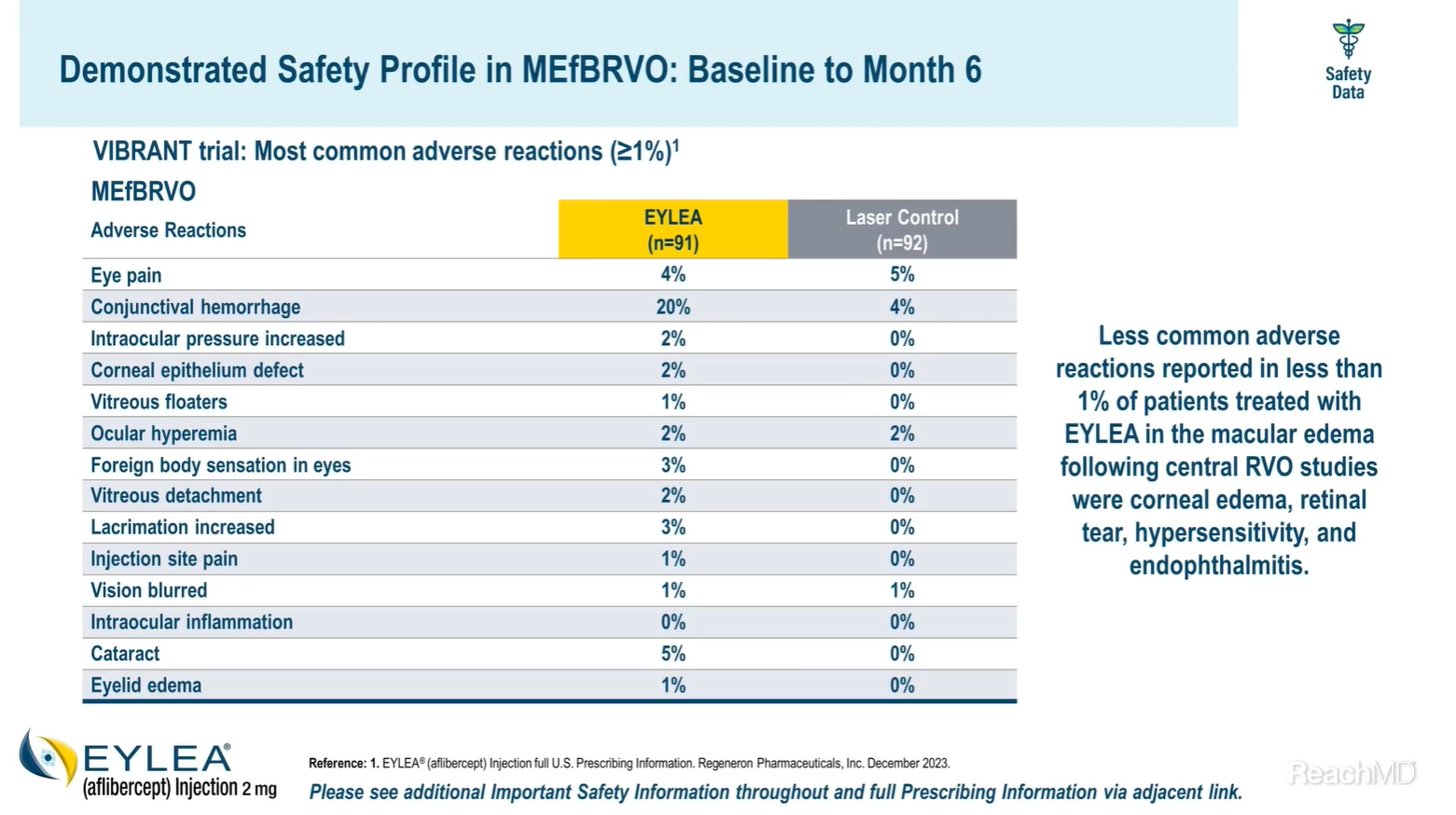
Well, in terms of safety, the most common adverse reactions (occurring in at least 5%) reported in patients with Macular Edema following Branch Retinal Vein Occlusion and receiving EYLEA from baseline to Month 6 were conjunctival hemorrhage and cataract.1 Less common adverse reactions can be seen on the screen.
[Slide on screen]
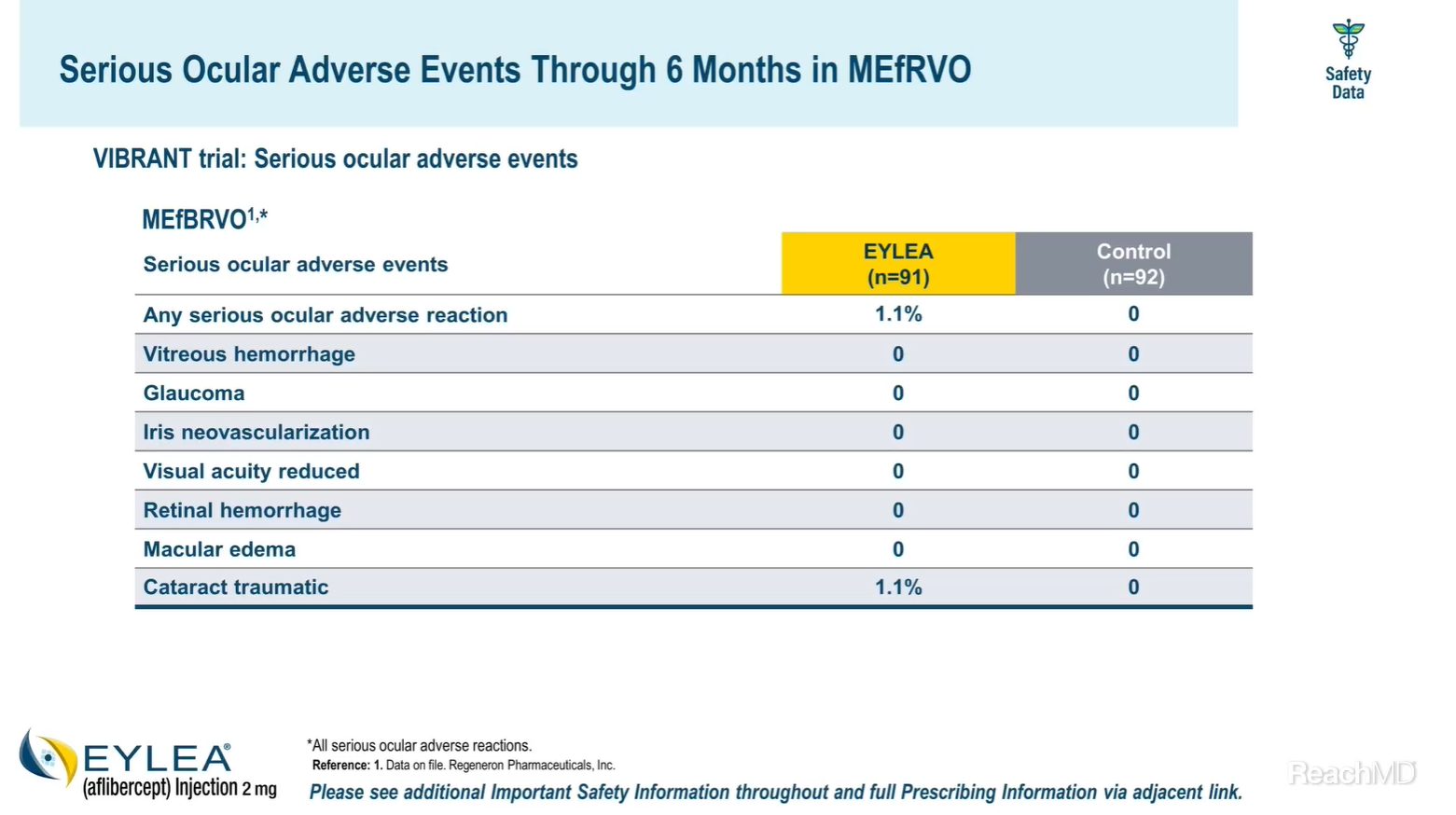
One serious ocular adverse event, traumatic cataract, was reported in the VIBRANT study through Week 24.2
Dr. Turck:
With this safety data in mind, let's finish reviewing the Important Safety Information for EYLEA® (aflibercept) Injection.
Narrator:
ADVERSE REACTIONS
Serious adverse reactions related to the injection procedure have occurred in <0.1% of intravitreal injections with EYLEA including endophthalmitis and retinal detachment.
The most common adverse reactions (≥5%) reported in patients receiving EYLEA were conjunctival hemorrhage, eye pain, cataract, vitreous detachment, vitreous floaters, and intraocular pressure increased.
Patients may experience temporary visual disturbances after an intravitreal injection with EYLEA and the associated eye examinations. Advise patients not to drive or use machinery until visual function has recovered sufficiently.
Dr. Turck:
As we wrap up, Dr. Kitchens, could you please share with our audience your key insights from our discussions today?
Dr. Kitchens:
Of course.
As I mentioned in our previous discussion, pivotal trials such as VIBRANT, COPERNICUS, and GALILEO have been instrumental in showcasing the efficacy and safety profile of EYLEA.1,3
Additionally, EYLEA is the number one prescribed anti-VEGF that is approved by the FDA for Wet AMD, DME, diabetic retinopathy and Macular Edema following Retinal Vein Occlusion, with more than 64 million doses administered worldwide across all indications since launch (and counting).3 This substantial real-world experience, paired with the clinical trial outcomes, are compelling reasons why I choose EYLEA for my patients with Macular Edema following RVO.
Dr. Turck:
With those key insights in mind, I would like to extend my gratitude to our guest, Dr. John Kitchens, here on behalf of Regeneron Pharmaceuticals, for helping us better understand the role of EYLEA in the treatment of Macular Edema following RVO. Dr. Kitchens, it has been a pleasure having you as our guest throughout these sessions.
Dr. Kitchens:
Thank you, Dr. Turck, for the opportunity to discuss EYLEA as a treatment option for Macular Edema following RVO. It's been a real pleasure joining these sessions, and I look forward to future collaborations.
ReachMD Announcer:
This program is brought to you by Regeneron. The speaker is a paid consultant.
References:
- EYLEA® (aflibercept) Injection full U.S. Prescribing Information. Regeneron Pharmaceuticals, Inc. December 2023.
- Campochiaro PA, Clark WL, Boyer DS, et al. Intravitreal aflibercept for macular edema following branch retinal vein occlusion: the 24-week results of the VIBRANT study. Ophthalmology. 2015;122(3):538-544.
- Data on File. Regeneron Pharmaceuticals, Inc.
- Kolar P. Risk factors for central and branch retinal vein occlusion: a meta-analysis of published clinical data. J Ophthalmol. 2014;2014:724780.
© 2024, Regeneron Pharmaceuticals, Inc. All rights reserved.
US.EYL.24.07.0006 08/2024














